Key takeaways:
- Palestinian crafts, such as pottery and embroidery, serve as vital connections to culture and identity, telling stories of heritage and resilience.
- The Palestinian Conference promotes traditional crafts through workshops, marketplaces, and discussions, fostering collaboration and innovation among artisans.
- Engagement with traditional crafts fosters community, belonging, and the transmission of cultural heritage across generations.
- Crafting is seen as a testament to resilience and a means of preserving history, emphasizing the importance of patience and collaboration in the creative process.
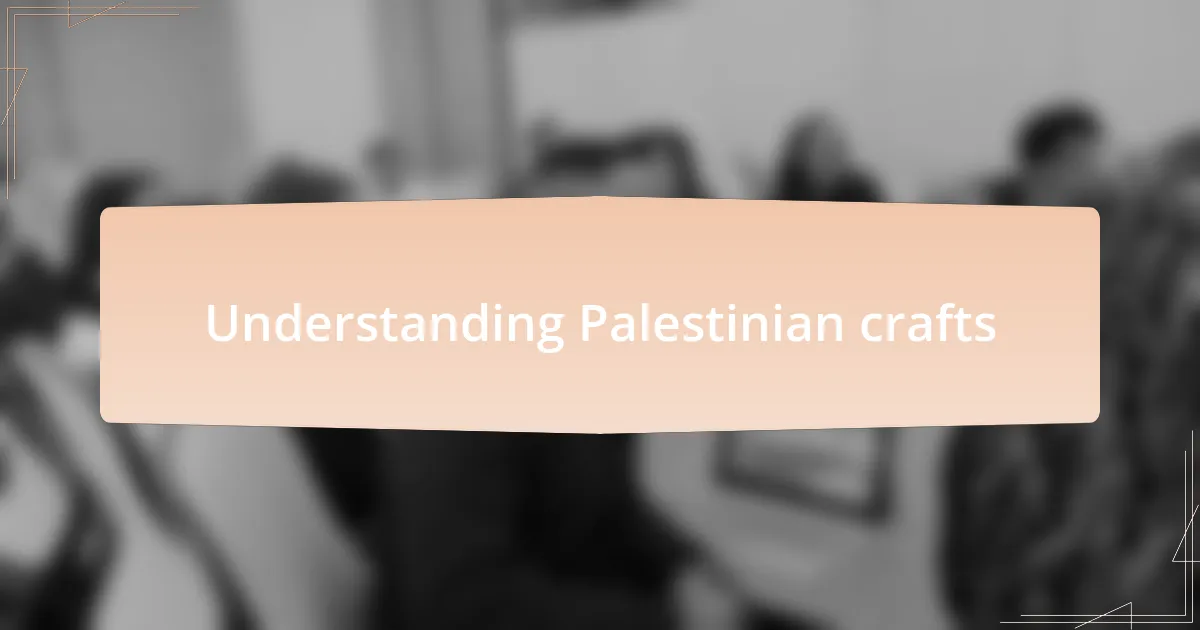
Understanding Palestinian crafts
Palestinian crafts embody a deep connection to culture and identity, serving as a tangible link to the history of the land. I remember the first time I held a piece of handcrafted pottery, its intricate design speaking volumes about the artisan’s dedication. How can a simple object carry so much heritage?
As I delved deeper into the world of embroidery, or tatreez, I felt a rush of emotion that words alone could hardly capture. Each stitch tells a story, often passed down through generations, making the cloth vibrant with memories and resilience. Isn’t it fascinating how something as simple as thread and fabric can weave together the fabric of a community’s past?
The woodwork I encountered during my explorations was mesmerizing, each piece meticulously shaped and designed. It made me ponder: why is it that certain crafts resonate so strongly with us? Perhaps it’s because they remind us of our shared humanity and the artistry that flourishes even amidst adversity.
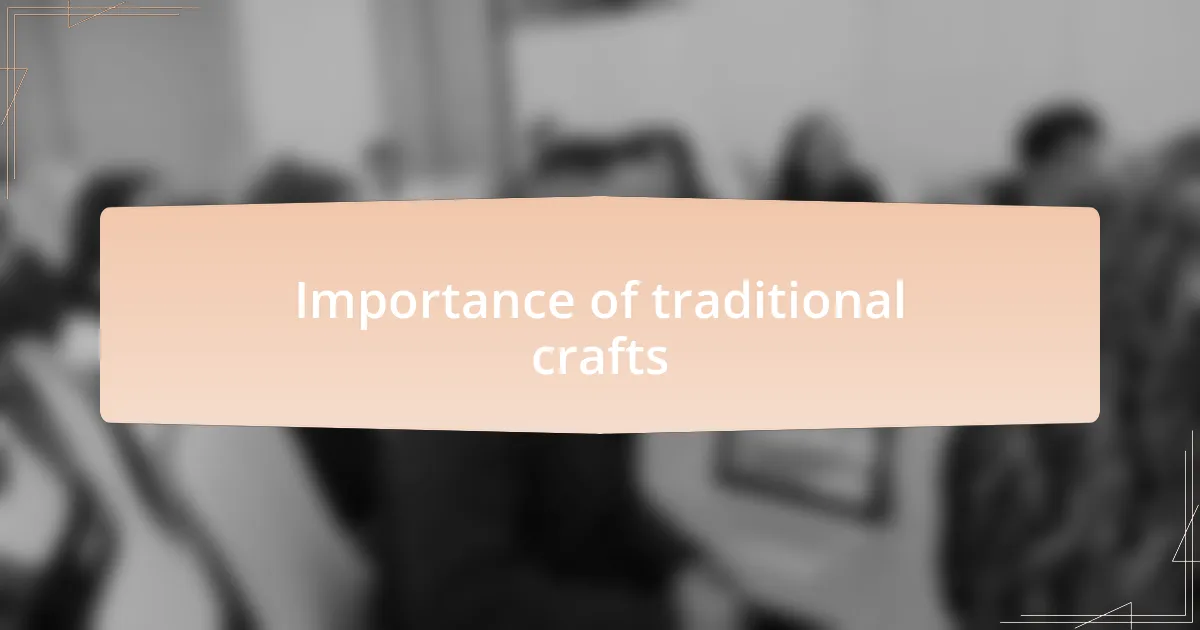
Importance of traditional crafts
Traditional crafts hold immense importance, as they serve not only as a means of livelihood but also as a keeper of cultural identity. When I witnessed artisans skillfully creating glassware, I was struck by how each piece echoed stories of resilience and celebration. How could something so beautifully crafted be tied to the struggles and triumphs of a community?
In my experiences, I’ve often felt that engaging with traditional crafts fosters a sense of belonging. I remember learning about the significance of patterns in Palestinian embroidery, where each design not only beautifies but also conveys messages of heritage and continuity. How powerful is it that a simple tunic can be a canvas for identity and history woven into every thread?
Moreover, the revival of these crafts acts as a form of resistance against cultural erasure. I was moved when a skilled potter spoke about their commitment to preserving ancient techniques, not just for themselves but for future generations. Isn’t it inspiring how these crafts can act as a bridge connecting the past to the future, ensuring that vibrant customs endure?
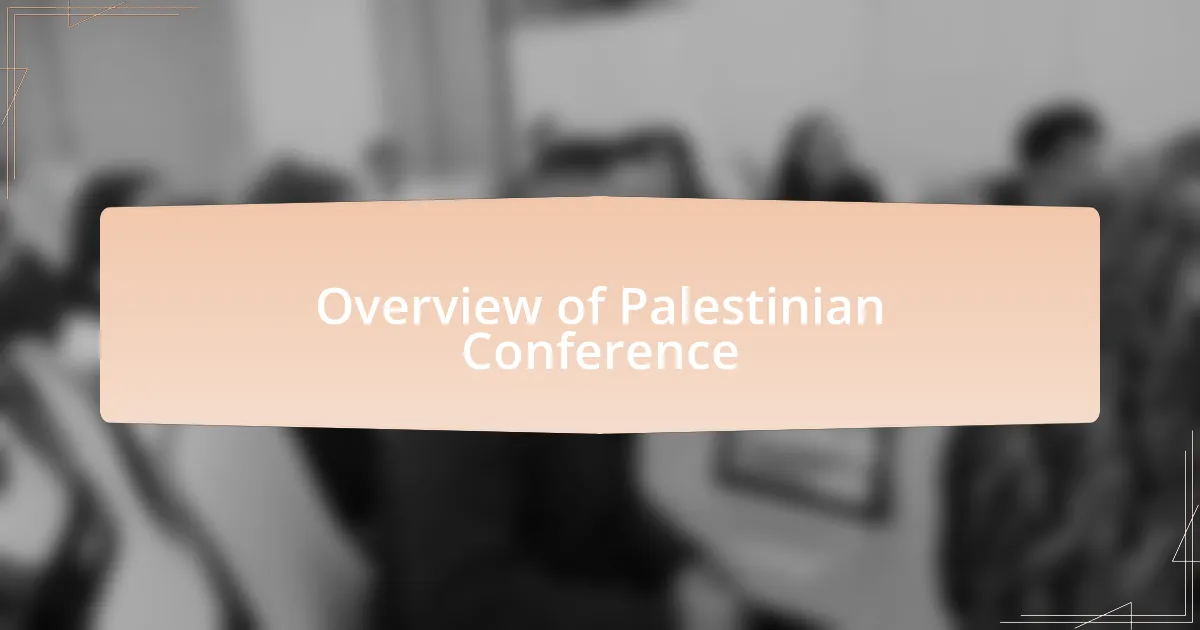
Overview of Palestinian Conference
The Palestinian Conference serves as a vital platform for showcasing the nation’s rich cultural heritage, including its traditional crafts. During my attendance, I marveled at the diversity of artisans and their unique creations, each telling a distinct story of skill and tradition. Isn’t it remarkable how such gatherings can spark conversations about identity and artistry?
What struck me most was the sense of community that permeated the event. I recall engaging with a group of women who passionately discussed their love for weaving, sharing insights into their creative processes. How often do we get to witness the seamless blending of culture, skill, and camaraderie in one space? The atmosphere at the conference truly highlighted the significance of preserving these crafts.
Additionally, the conference encourages collaboration between craftsmen and artists, fostering innovation while maintaining traditional techniques. I found it inspiring when a young designer explained how they blend modern aesthetics with ancestral methods in their work. Aren’t these moments key in ensuring that the legacy of Palestinian crafts continues to evolve and thrive?
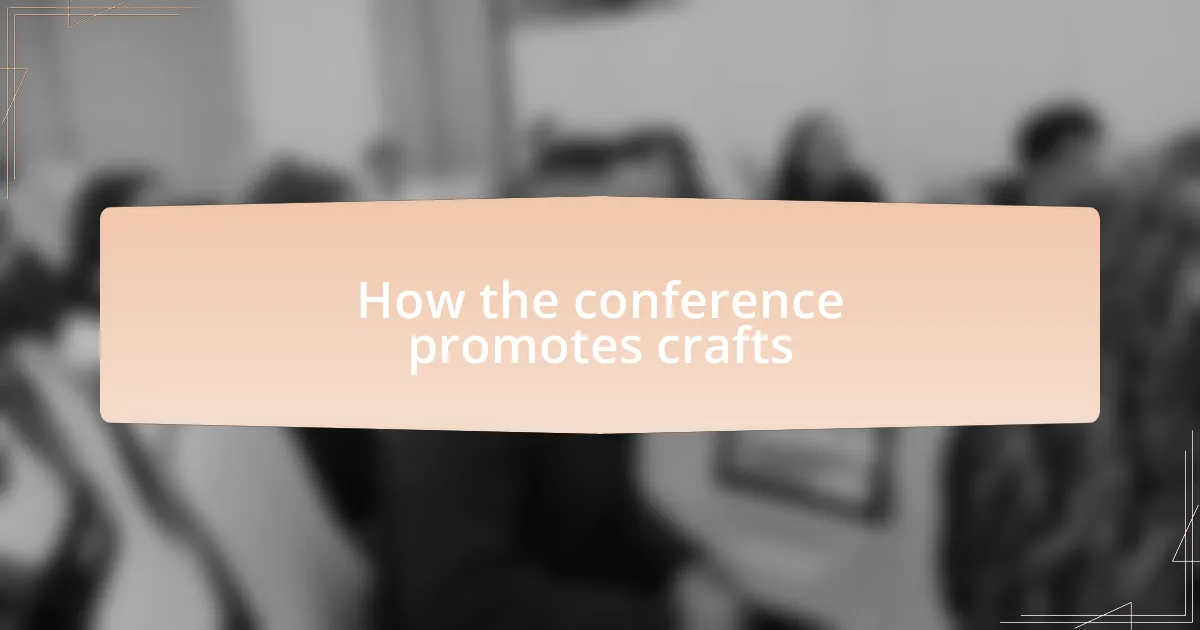
How the conference promotes crafts
The conference actively promotes Palestinian crafts by hosting workshops that allow artisans to demonstrate their techniques to attendees. I remember sitting in on a pottery workshop where the artisan shared not just skills, but the stories behind each piece. Isn’t it fascinating how much deeper our appreciation for these crafts grows when we learn the history and passion infused in every creation?
Furthermore, the conference serves as a marketplace where craftspeople can showcase their work directly to the public. I was particularly struck by a young woman’s booth filled with intricately designed embroidery. As she described the symbolism of each stitch, I couldn’t help but feel a connection to the tradition she represented. Wouldn’t it be wonderful if more people experienced that emotional link to their purchases?
Another significant aspect is the inclusion of panel discussions that revolve around the future of traditional crafts. During one such discussion, an expert emphasized the importance of securing fair trade practices for artisans, which resonated deeply with both the audience and myself. How vital is it for us to ensure that the very creators of these beautiful works are supported and recognized in today’s market?
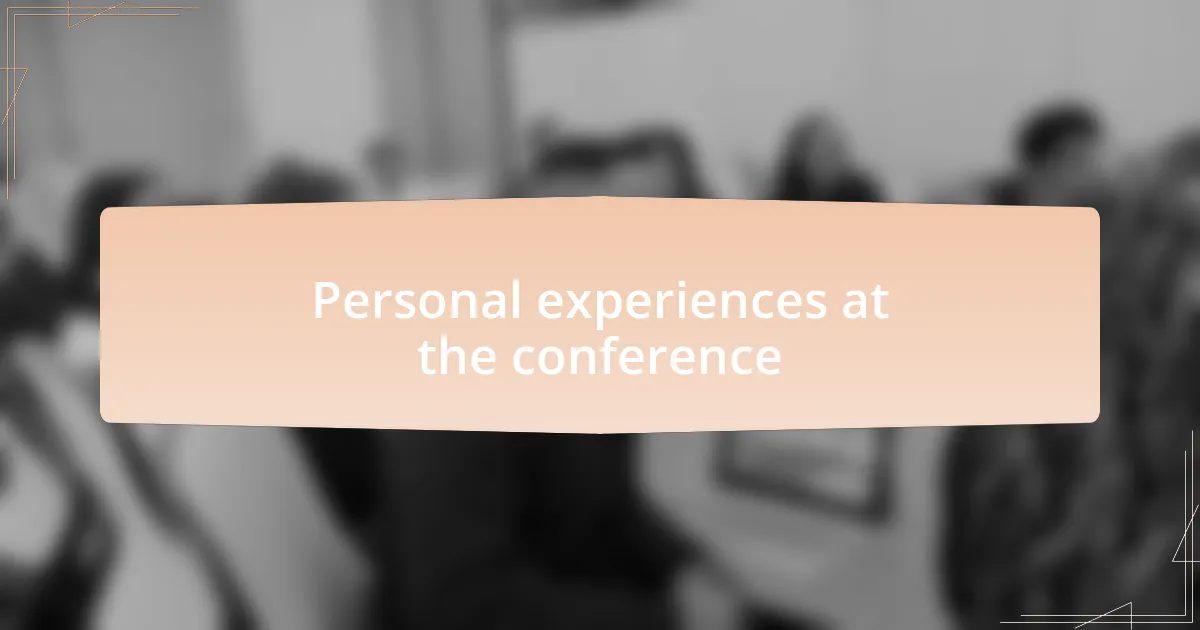
Personal experiences at the conference
As I explored the conference, I stumbled upon a corner where traditional weaving was being demonstrated. The artisan there was so engrossed in his craft that it felt like time stood still. I was captivated not just by the colors and patterns but by the joy radiating from him as he wove stories into every thread. It made me wonder, how often do we take the time to appreciate the artistry that surrounds us in daily life?
During a lunch break, I found myself at a table with several attendees who shared their experiences with Palestinian crafts in their own communities. One woman recounted how she organized workshops for children, highlighting the importance of passing down these traditions. Listening to her, I realized how vital these connections are not just for preserving crafts, but for fostering a sense of belonging. Isn’t it incredible how crafts can bridge generations and cultures?
At one point, I joined a small group gathered around a demonstration of traditional ceramics. The artisan’s hands worked effortlessly, molding clay into beautiful shapes as he spoke of his grandmother’s influence on his craft. It struck me how deeply intertwined our personal histories are with the arts we create. This made me reflect: in what ways does our own heritage shape the art we appreciate or pursue?
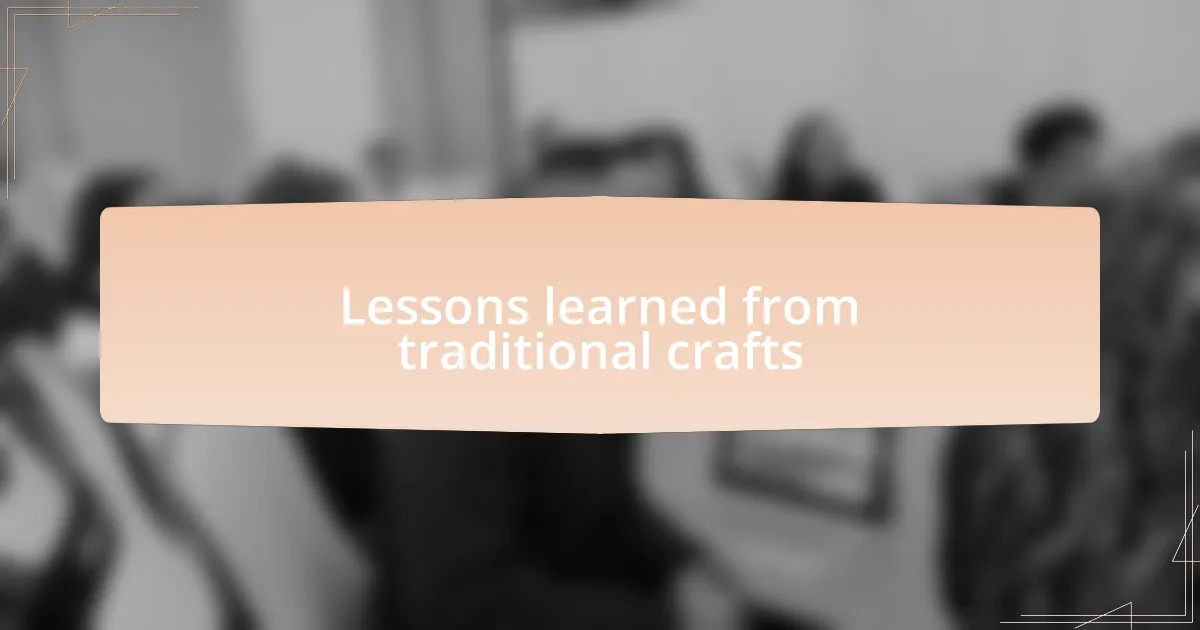
Lessons learned from traditional crafts
Crafting is more than just a skill; it’s a testament to resilience and identity. I remember a conversation I had with an elderly artisan who shared his experiences during difficult times. He emphasized how traditional crafts acted as a refuge, allowing him to connect with his roots and express his heritage. Isn’t it fascinating how creativity can serve as both a sanctuary and a way of preserving history?
As I participated in a pottery workshop, I learned the importance of patience. Shaping clay required not only skill but also a gentle touch and time to let the art evolve naturally. This process resonated deeply with me, reminding me that much like in life, great things come to those who are willing to invest effort and wait for their vision to unfold.
Witnessing artisans collaborate on a mural painted with traditional patterns, I was struck by the power of community in the world of crafts. Each stroke of the brush was not just an artistic choice, but a shared narrative, intertwining individual stories into a collective masterpiece. Can you think of a time when you participated in something larger than yourself? It’s moments like these that highlight the beauty of traditional crafts—they unite people across backgrounds and create lasting bonds.